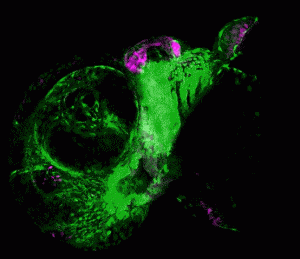
Scientists in the USC Stem Cell laboratory of Gage Crump have revealed how key genes guide the development of the jaw in zebrafish. These findings may offer clues for understanding craniofacial anomalies in human patients, who sometimes carry a mutation in equivalent genes.
In the study published in Developmental Cell, first author Lindsey Barske and colleagues report that two related genes, called Nr2f2 and Nr2f5, pattern the jaw by regulating the timing by which stem cells generate skeletal cells. As in our bodies, the fish skeleton generally starts out as cartilage and is later replaced by bone. However, most upper jaw bones develop without any cartilage template. Nr2f genes prevent stem cells in the developing upper jaw from becoming cartilage early on, so that they are available to make more bone later. This is in contrast to the lower jaw, where another gene called Endothelin1 (Edn1) prevents Nr2f activity and allows for the formation of extensive early cartilage that drives the outgrowth of the lower jaw.
To read more, visit stemcell.keck.usc.edu/usc-stem-cell-scientists-chew-on-the-mysteries-of-jaw-development.
